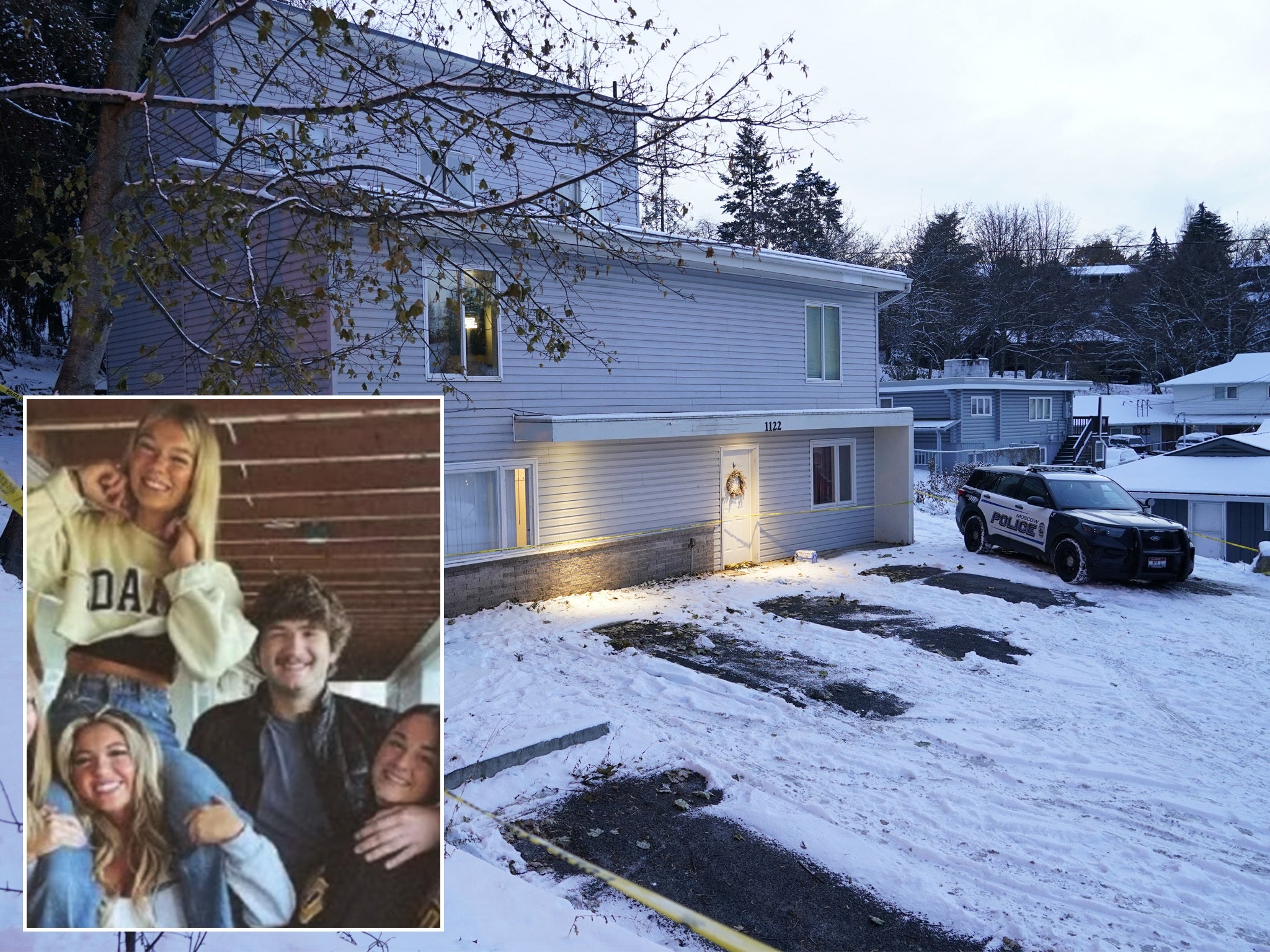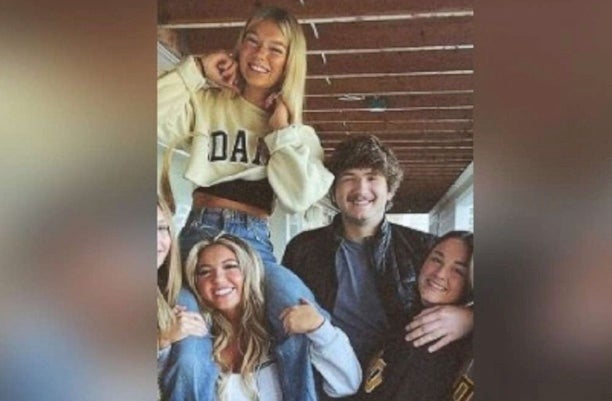Timeline of the Idaho college murders
One year on from the murders of four University of Idaho students, Io Dodds charts out the entire case


In November 2022, four University of Idaho students were found stabbed to death at a rental house in Moscow, mere hours after posting smiling photographs together on Instagram.
The case shocked the small college town and drew media attention from across the world, yet for nearly seven weeks there appeared to be no suspect in the case.
Then, on 30 December, Bryan Kohberger – a PhD student in criminology at Washington State University (WSU) – was suddenly arrested and charged with their murders.
In May, a grand jury indicted MrKohberger on four counts of first-degree murder and one burglary charge, effectively rerouting the case directly to the state’s felony court level and allowing prosecutors to skip the preliminary hearing process.
After months of unanswered questions, the grieving relatives of Kaylee Goncalves, Madison Mogen, Xana Kernodle and Ethan Chapin faced their children’s accused killer in court, only for Mr Kohberger to refuse to enter a plea on the murder charges.
In August, Mr Kohberger waived his right to a speedy trial, postponing the proceedings indefinitely.
Here’s a timeline of the case so far:

12 November 2022 – ‘One lucky girl’
At 8.57pm local time on 12 November, Goncalves posted for the last time on Instagram.
It was a picture of herself and the three other slain students standing together arm-in-arm on the porch of a house.
The two other roommates Dylan Mortensen and Bethany Funke who lived at the home with Mogen, Goncalves and Kernodle on King Road are also in the photo.
“One lucky girl to be surrounded by these people everyday,” Goncalve wrote in the caption.
That night, Chapin and Kernodle went to a party together on the university campus, while Mogen and Goncalves went to a bar in town.
13 November, 1.41am – Victims last seen alive in footage
In the early hours of Sunday morning, Mogen and Goncalves were seen stopping by a local food truck for a late-night bit to eat.
Twitch footage seen by The Independent captured the two best friends arriving at the food truck at around 1.41am.
Officers later said that Mogen and Goncalves “used a private party” for a ride home from the downtown area after visiting the food truck. The driver dropped them off at their home at around 1.45am.
Meanwhile, Chapin and Kernodle were seen at the Sigma Chi fraternity house, and also returned home around the same time.
The two other surviving roommates had also been out on Saturday night and returned to the property at around 1am, police said.
Goncalves’s sister revealed that multiple calls were made from the phones of Goncalves and Mogen to the phone of Goncalves’ former longtime boyfriend between 2.26am and 2.52am.
Between the two best friends, 10 calls were made, but none were answered.
13 November, 2.44am – Suspect’s car is spotted
Not long after, according to court documents released by Latah County prosecutors, a car matching the description of Bryan Kohberger’s Hyudai sedan was recorded on surveillance cameras at Washington State University, where the 28-year-old is a crimonology graduate student.
Ten minutes later, the car was spotted heading towards SR 270, a road which connects the town of Pullman, Washington, to nearby Moscow, Idaho.
At roughly the same time the sedan was likely heading towards Moscow, Mr Kohberger’s cell phone pinged off towers near the his apartment in Pullman, and later showed on cell towers in Idaho in the hours directly after murders.
13 November, 3am to 4am – Murders
Officials believe the students were killed some time between 3am and 4am on Sunday 13 November).
All four were stabbed to death with an “edged weapon such as a knife” – though the murder weapon has not been found.
There was no sign of forced entry, the door appeared to be unlocked and nothing seems to have been taken.
The two other roommates were home at the time of the attack but were unharmed. Police said that they were not necessarily witnesses to the incident, there was no hostage situation and they appear to have slept through the murders.
Latah County Coroner Cathy Mabbutt said the victims were “likely sleeping” when they were killed, as all four were found in bed, and were stabbed multiple times.
According to the Latah County records, the car appearing to be Mr Kohberger’s vehicle was seen on various surveillance cameras near the students’ home between 3.29 and 4.20am, before appearing once again in Pullman at 5.25 near the WSU campus.
13 November, noon – Investigation begins
Law enforcement officers arrived at the house at 11.58am on Sunday after getting a 911 call from the cell phone of one of the surviving roommates (though police refused to confirm who).
Officers said that the roommates woke up on the Sunday and called some unidentified friends to the home because they believed that one of the victims on the second floor “had passed out and was not waking up”.
The four victims were discovered stabbed to death in their beds on the second and third floors of the house.
16 November – Autopsy findings released
Autopsy findings for the victims were released on Thursday, officially ruling their deaths homicides by stabbing.
Latah County Coroner Cathy Mabbutt confirmed that each victim was stabbed multiple times with a “large knife”, describing their wounds as “pretty extensive” and revealing that they bled out inside their student home.
She said the autopsies confirmed that the victims were killed “early in the morning, sometime after 2am, but still during the night” but that it was not been possible to determine from the injuries the order in which the victims were attacked.
DNA samples and nail clippings were also taken from the crime scene with the coroner saying that it is “possible” that the tests could turn up DNA from people besides the victims.
A local prosecutor revealed that investigators were exploring the possibility that more than one killer is responsible for the killings, while officers were reportedly searching for a military-style Ka-Bar knife believed to be the murder weapon.
7 December – Police seek a white car
An initial breakthrough seemed to come when police announced that they were looking for the owner and occupants of a white Hyundai Elantra that was spotted near the crime scene “in the early morning hours” on the day of the murders.
Detectives did not reveal whether the owner of the white 2011-2013 Hyundai Elantra is believed to be a suspect but said that “the occupant(s) of [the] vehicle may have critical information to share regarding this case.” The licence plate is unknown.
The car was “in the immediate area” of the rental home on King Road in the early hours of 13 November. The murders are thought to have taken place between 3am and 4am.
The development was quickly linked in online sleuth communities to body-camera footage from a separate incident on the night of the killings, which police said stemmed from an alcohol offence just before 3am.
Officials would later shut down speculation around the video, telling The Independent on 8 December that the incident on the body-camera footage was in no way connected to the murders and the white car in the background was not the same one they were seeking information about.
15 December – Two key traffic stops
As police closed in Bryan Kohberger, the graduate student made his way across the country with his father, driving from Washington to spend the holidays with family in Pennsylvania.
By then, officials later revealed, police were on to the 28-year-old, and Indiana police pulled the pair over twice during their journey.
The stops came at the request of the FBI who were seeking images of the suspect’s hands as part of the investigation into the quadruple homicide of Kaylee Goncalves, Madison Mogen, Xana Kernodle and Ethan Chapin back in Moscow, Idaho.
It is not clear why images of Mr Kohberger’s hands were important to the investigation or if the officers managed to obtain anything of interest by carrying out the stops on 15 December.
30 December, early morning – Mountain raid
Finally, at around 1.30am local time on 30 December, local police and FBI swooped on a home in Albrightsville, Pennsylvania, near ski resorts in the Pocono Mountains and arrested a 28-year-old criminology graduate student named Bryan Christopher Kohberger.
According to reports, the property appeared to be Mr Kohberger’s parents’ house in a gated community. A white Hyundai Elantra was also seized.
NewsNation correspondent Brian Entin said that the suspect “asked if anyone else was arrested” and had a “quiet, blank stare”, citing inside sources.
30 December, 8am – News breaks
Later that day the Moscow Police Department and prosecutors held their first press conference since 23 November, revealing that Mr Kohberger had been charged with four counts of first degree murder.
They declined to give details on how he had come to be arrested and charged but said they still wanted to hear from members of the public who may have information about what happened.
Meanwhile, several insiders have provided crucial details to the media. One law enforcement official told CNN that Mr Kohberger was identified through genetic testing that linked DNA at the crime scene to his relatives.
Sources say authorities then confirmed that Mr Kohberger owned a white Hyundai Elantra like the one spotted near the crime scene on the night of the murders.
Investigators reportedly tracked Mr Kohberger as he drove more han 2,000 miles from Washington state to Pennsylvania, where he was surveilled for days before being taken into custody.
31 December – Charges filed
Shorly after his arrest, Mr Kohberger was charged with four counts of first-degree murder, as well as felony burglary. But the legal process didn’t end there.
4 January – The suspect returns to Idaho
The 28-year-old arrived in Moscow in the late evening, where a group of officers walked the suspect into a waiting truck.
Mr Kohberger appeared to be wearing body armour as police led him into custody. On 4 Judge, the judge also issued a gag order, banning investigators, law enforcement personnel, attorneys, and members of both the prosecution and the defence from sharing any new information about the investigation or the suspect before a verdict is reached at trial.
As a result Moscow Police Department, which had been sharing updates on the investigation, said in a statement that it will no longer be communicating with the public or the media regarding the case.
5 January – Kohberger appears in court
After weeks of investigations, police and community members alike finally got what they wanted: a suspect, in Idaho court, facing charges for the four University of Idaho murders.
Mr Kohberger appeared in a Latah County court for the first time, where he heard the charges against him, had his bail rights revoked, and faced down crying family members of his alleged slain victims.
12 January - Kohberger waives preliminary hearing
Mr Kohberger appeared in Latah County Courthouse with cuts on his face as he waived his right to a speedy trial on charges of murdering the four Idaho students.
Mr Kohberger’s public defender Anne Taylor then requested that his next court date be pushed back until June.
The prosecution agreed to the request and the judge scheduled the preliminary hearing for the week beginning 26 June.
19 January - Idaho police unseal search warrants
Police investigating the murder of four Idaho students seized a string of items from suspect Mr Kohberger’s apartment, including possible hair strands, a disposable glove, items with red and brown stains and a computer, according to a newly unsealed search warrant.
Police said that one of the items found at the suspect’s apartment at nearby Washington State University was a “possible animal hair strand.” In the documents, investigators said one item had a “collection of dark red” spotting, and that a pillow had a “reddish/brown stain” on it.
The application also stated that the murder scene near the University of Idaho campus where the victims were discovered had a large amount of the victims’ blood “including spatter and castoff” blood.
28 February - Search warrant reveals items seized in Pennsylvania
The search warrant application was filed in Pennsylvania’s Monroe County court on 29 December, the day before Mr Kohberger’s arrest. It approved a search of the family residence, the adjacent garage and the suspect’s car.
It allowed investigators to collect “blood, or other bodily fluid or materials and items with blood” - but the list of seizures does not mention any such items.
Investigators seized nine items: one Defiant-brand silver flashlight, four medical-style gloves, a large white t-shirt, a pair of black and white size 13 Nike shoes and a pair of black Under Armor shorts. They also took a buccal swab, possibly from Mr Kohberger.
27 March - Prosecutors reveal officer is under ‘internal affairs investigation’
In a filing, authorities disclosed the existence of a Giglio/Brady list that could potentially affect the ongoing criminal proceedings against Mr Kohberger, the only suspect in the case.
“ ...the State has become aware of potential Brady/Giglio material related to one of the officers involved in the above-referenced case,” the filing stated.
Under Brady law, investigators are responsible for disclosing exculpatory information to defence counsel. Meanwhile, Giglio material conveys information that could potentially indicate that a witness is not credible, according to the National Association for Civilian Oversight of Law Enforcement.
The scope of the list and the role of the officer in the murder investigation were not immediately clear. The evidence mentioned in the recent filing was submitted in camera to the court on 24 March, but its content remains sealed at the request of prosecutors.
5 May - Kohberger’s belongings test positive for blood
Court documents, released by Washington authorities showed that multiple items taken from the 28-year-old Washington State University criminology PhD student’s apartment in Pullman had been tested for the presence of blood.
While most items came back negative, two items were positive.
Those items were a mattress cover on the bed and an uncased pillow, both of which were described as having visible “reddish brown stains”. The documents did not reveal who the blood belongs to.
13 May - Victims’ families accept posthumous degrees
Six months after the victims were killed in their sleep at their off-campus home in Moscow, their loved ones received the awards during two separate ceremonies.
Goncalves’ four siblings received their sister’s general studies diploma while Mogen’s parents were given her marketing degree. Kernodle’s family accepted her certificate in marketing at a previous private ceremony while Chapin’s award in sports, recreation and management was mailed to his parents.
16 May - Kohberger indicted by grand jury over Idaho murders
A grand jury indicted MrKohberger on charges of burglary and four counts of murder, allowing the parties to skip the previously planned 26 June preliminary hearing.
Each murder count states that he “did wilfully, unlawfully, deliberately, with premeditation and with malice aforethought, kill and murder” each of the victims by stabbing.
The list of witnesses who testified before the grand jury is sealed. Mr Kohberger’s indictment means that the jurors empanelled on the grand jury believed there was enough evidence against him for the case to proceed to trial.
22 May - Kohberger refuses to enter plea
Mr Kohberger refused to enter a plea in Latah County District Court, prompting the judge to make one on his behalf.
His attorney said that he was “standing silent” on the charges.
Several members of Kaylee Goncalves’ family were present in the courtroom, facing the man accused of killing their 21-year-old daughter as he declined to enter a plea.
The judge set Mr Kohberger’s trial date for 2 October 2023 following requests by Kohberger’s attorney and the state. The trial is expected to take around six weeks.
26 June – Prosecutors seek death penalty
Latah County Prosecutor Bill Thompson filed a notice of his intent to seek the death penalty in court in Moscow, Idaho, citing five “aggravating circumstances” that could warrant the maximum sentence of capital punishment being sought.
These circumstances include that the murder was “especially heinous, atrocious or cruel, manifesting exceptional depravity” and that the defendant showed “utter disregard for human life”.
“The State gives this notice based on the fact that it has not identified or been provided with any mitigating circumstances sufficient to prohibit the triers of fact from considering all penalties authorized by the Idaho legislature including the possibility of a capital sentence,” prosecutors wrote in the filing.
“Consequently, considering all evidence currently known to the State, the State is compelled to file this notice of intent to seek the death penalty.”
3 August - Kohberger presents alibi
On 3 August, Mr Kohberger’s defence presented an alibi for the night of the murders.
In a court filing, attorneys said the accused killer “has long had a habit of going for drives alone” and that he did so on the night of and morning after the murders.
23 August - Trial postponed indefinitely
In a shock twist on 23 August, Mr Kohberger waived his right to a speedy trial in a move which postponed the proceedings indefinitely.
His attorney Anne Taylor told the court that he chose to waive because his defence did not expect to be ready for the planned trial in October.
27 October - Kohberger loses bid for dismissal
On 27 October, Mr Kohberger appeared in court for a hearing on a motion to dismiss the indictment against him.
The defence argued that the grand jury which brought the indictment had been improperly handed.
Judge John C Judge disagree, ruling that the indictment will stand.



